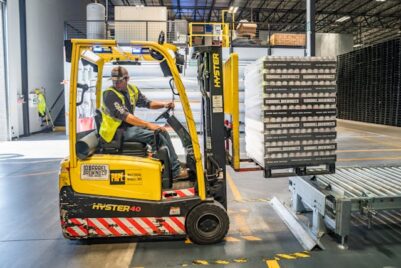Workplace injuries are a serious issue in industrial settings. Whether it’s a busy warehouse, a construction site, or a loading dock, accidents can happen fast. While some situations are unpredictable, many injuries are linked to poor equipment habits. These can be avoided with a few steady practices.
A lot of companies focus on productivity and speed. That matters, but not at the cost of safety. The truth is, equipment-related injuries are often preventable. Small problems can lead to big issues when no one is paying attention. That’s why creating better habits around equipment use, checks, and repairs can make a major difference.
Improving safety doesn’t have to mean expensive upgrades or complicated training programs. Most of the time, it comes down to better awareness, more consistent checks, and a willingness to fix things before they fail. A safer workplace starts with how you treat the tools and machines your team uses every day.
Perform Routine Equipment Checks and Replace Worn Parts Early
Waiting for a machine to fail before doing maintenance can be a dangerous move. Regular inspections help catch problems before they cause accidents. Many issues show signs before they become serious. Ignoring them increases risk for both workers and operations.
Some companies only schedule maintenance when something breaks. However, machines that run daily should be checked more often. A quick visual check before use can help prevent most common issues. Look for signs like leaks, loose bolts, worn tires, or strange noises.
Let’s use forklifts as an example. These are used every day in warehouses, distribution centers, and construction sites. If a forklift runs eight hours a day, it’s under a lot of strain. Even if the operator handles it well, parts wear down over time.
If a forklift is used daily, small problems can build up fast. Worn tires, loose chains, or damaged forklift parts can increase the risk of tipping, reduced braking power, or load drops—all of which lead to injuries. This is why inspections are important. You don’t need to overthink it—just build a habit of checking basic components every day before use.
When parts need replacing, don’t delay. Waiting a few more shifts to “make it through the week” can backfire. Accidents often happen when a known issue is ignored. Keep basic parts in stock if you rely heavily on certain machines. It’s faster and safer than trying to rush a last-minute order when something fails.
Certified or brand-approved parts matter too. Cheap replacements may seem like a quick fix, but they don’t always hold up. Stick with trusted suppliers. The upfront cost is worth it when you factor in safety and downtime.
Train Operators and Technicians the Right Way
Even the best equipment can become a hazard in the wrong hands. Training isn’t something you do once. It needs to be part of how your team works day to day. New hires should go through clear onboarding, but long-time employees benefit from regular refreshers, too.
Hands-on training helps workers understand how each machine works and what to watch for. That includes how to spot wear, what warning signs mean, and when to report an issue. When people know what to look for, they’re less likely to ignore something that seems small.
Operators should also know how to handle equipment properly under different conditions. Slippery floors, uneven surfaces, and tight spaces change how machines behave. Technicians need to be clear on safe lockout procedures, part replacements, and basic diagnostics.
Training sessions don’t have to take up an entire day. A 30-minute check-in or a short demo during a team meeting can keep everyone sharp. When people are confident in what they’re doing, they work smarter and safer.
Keep Maintenance Logs and Track Issues Over Time
Most teams fix problems as they come up. But without a record, it’s hard to know if the same issue keeps happening. Keeping a maintenance log helps track wear patterns and spot machines that might be nearing the end of their cycle.
Start simple. Use a spreadsheet or maintenance app to log repairs, inspections, and part replacements. Include who reported the issue, what was fixed, and how long it took to get it back in service. You can review this log every month to look for trends.
If a certain machine is breaking down more often or taking longer to repair, it might be time to take a closer look—or even replace it. Logs help make better decisions backed by data, not guesswork.
They also make communication easier across shifts. If a day shift notes a problem, the night crew can follow up without repeating steps. This keeps everyone informed and improves the chances of catching issues early.
Set Clear Daily Use Guidelines for All Equipment
Every machine should come with basic dos and don’ts. But workers often rely on memory or word of mouth to know what’s acceptable. Set clear use guidelines and make sure everyone follows them, every shift, every day.
Post rules near workstations. Include reminders like weight limits, daily checks, safe speeds, and proper shutdown steps. These rules should be part of training, but they also need to stay visible.
Having consistent rules helps everyone stay accountable. Supervisors and team leads should check that guidelines are followed, but peer support is just as important. When rules are clear, they’re easier to follow—and enforce.
Upgrade or Retire Old Equipment That Poses a Risk
No machine lasts forever. Some equipment may still run, but that doesn’t mean it’s safe. Frequent repairs, noisy operation, and outdated controls are signs that it may be time to move on.
Evaluate each machine by looking at age, repair frequency, and how often it causes delays. If something breaks down more than it works, it could be putting your team at risk.
Upgrades don’t have to be expensive. Replacing guards, improving lighting, or switching out older seats can make older machines safer without replacing them fully. When the cost of keeping something running outweighs its value, it’s time to consider a new option.
Workplace safety starts with smart equipment practices. When you take the time to check, maintain, and use machines the right way, you lower the risk of accidents. Every small step adds up. It’s not about making things harder; it’s about making work safer, smoother, and more reliable for everyone involved.












